Introduction
Theory of Operation
The local oscillator (U4) is a programmable oscillator, whose programmatic parameters are set by the USB interface, U2.
The user, operating special SDR software on the PC, selects a desired center frequency. The PC issues commands, via a USB port, to U2 (the USB control chip from the preceding stage. These commands will result in U4's producing a frequency that is exactly 4 times the desired center frequency selected in the SDR program.
U2 responds to commands from the PC, translating them into commands in the I2C protocol to control the programmable oscillator U4. (If the I2C commands are not received by U4, it would default to an output frequency of 56.320 mHz.)
The IC U5 is needed if the version of U4 is the "LVDS" version. If U4 is a CMOS version, U5 (and R8) are not required and, instead, a jumper wire is installed to bypass them.
This LO stage must produce an output rf signal (available at J1 pin 4) that is four times the desired center frequency for the radio. This is then fed to the dividers/phasors section to produce the two center-frequency signals that are in quadrature and ¼ the LO frequency.
Schematic
This is a subset of the overall schematic. Note: red dot indicates resistor testpoints (hairpin, top, or left-hand lead)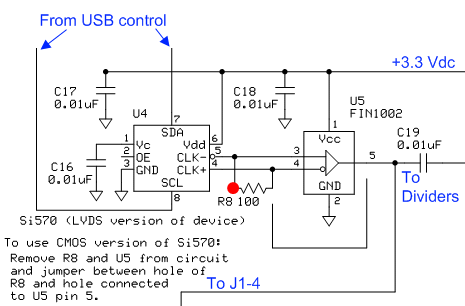
Bill of Materials
| Designation | Value | Color/Code | Orientation | Category | Notes |
|---|---|---|---|---|---|
| U5 | FIN1002 | FN02X |
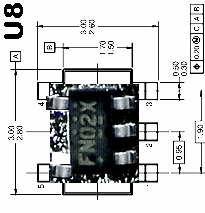 | SMT | only required for LVDS version of Si570 |
| U4 | Si570 (CMOS version of device) |
 | SMT | ||
| C16 | 0.01uF | SMT 1206 | |||
| C17 | 0.01uF | SMT 1206 | |||
| C18 | 0.01uF | SMT 1206 | |||
| R08 | 100 |  | flat-h | omit for CMOS | |
| J1 | 9 pin | ||||
| C19 | 0.01uF | 103 | ceramic |
Summary Build Notes
- Install U5 - only for LVDS version of Si570 (bottom)
- Install U4 (bottom)
- Install 3 SMT capacitors (bottom)
- Install resistor (top, if LVDS)
- Install main bus jack, J1
- Install ceramic cap C19
- Install CMOS jumper wire (if Si570 is CMOS versio)
- Test the Stage
Detailed Build Notes
Bottom of the Board
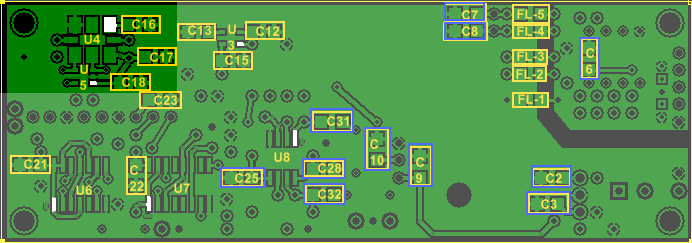
Install U5
| Designation | Value | Color/Code | Orientation | Category | Notes |
|---|---|---|---|---|---|
| U5 | FIN1002 | FN02X |

|
SMT SOT-23 | LVDS only: do not install if U4 is a CMOS version. |
Install U4
Note: There are two versions of the Si570, the CMOS and the LVDS. See the chart below for how to distincuish them (the chips are shown in their mounting orientation for this kit). See Softrock Group message for discussion of differences.

| Designation | Value | Color/Code | Orientation | Category | Notes |
|---|---|---|---|---|---|
| U4 | Si570 |

|
SMT | (LVDS version shown) |
Install SMT Capacitors
| Designation | Value | Color/Code | Orientation | Category | Notes |
|---|---|---|---|---|---|
| C16 | 0.01uF | SMT 1206 | |||
| C17 | 0.01uF | SMT 1206 | |||
| C18 | 0.01uF | SMT 1206 |
Top of the Board
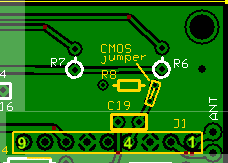
Install Resistor (see notes)
| Designation | Value | Color/Code | Orientation | Category | Notes |
|---|---|---|---|---|---|
| R08 | 100 |  | flat-h | omit for CMOS |
Install Ceramic Capacitor C19
| Designation | Value | Color/Code | Orientation | Category | Notes |
|---|---|---|---|---|---|
| C19 | 0.01uF | 103 | ceramic |
Install CMOS Jumper (only required of Si570 is CMOS version
| Designation | Value | Color/Code | Orientation | Category | Notes | |
|---|---|---|---|---|---|---|
| short jumper wire |
Install Main bus Jack J1
| Designation | Value | Color/Code | Orientation | Category | Notes |
|---|---|---|---|---|---|
| J1 | 9 pin |
Completed Stage
Topside
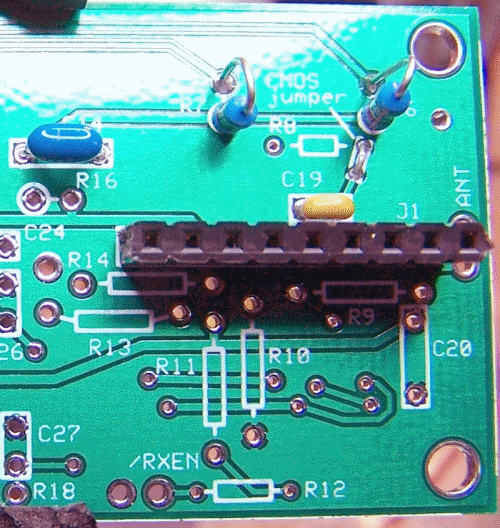
Bottomside
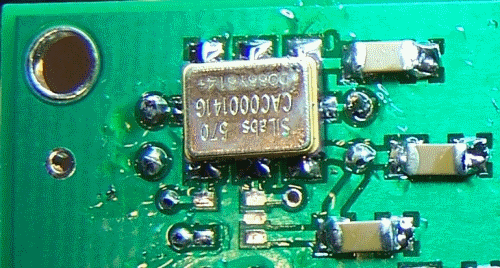
Testing
Current Limited Power Test
- Connect a 1 k ohm resistor in series with the power line and apply 12 V dc power
- the current should be relatively low (around 10 mA or less). Author's results = 8.1 mA
- Measure the voltage WRT ground at the +5 V testpoint at J2.
- A voltage of around 1-2 V dc indicates the power rail is not shorted. Author's results = 997 mV
Current Draw (DMM)
- Current draw here is for the CMOS version of the Si570. Adjust these numbers up by about 14 - 20 mA for the LVDS version.
- With the USB cable unplugged, power up the board, and measure the current draw. This should now go to around 70-80 mA. Author's results 75.4 mA
Si570 Test (courtesy of DG8SAQ)
This test uses theSi570_USB_Test.exeprogram which comes with the
Si570 drivers you downloaded and installed in the preceding (USB Control) stage.
Test Setup

go to the directory into which you extracted the contents ofSI570_firmware.zipand run theSi570_USB_Test.exeprogram- power up the board and plu.g in the USB cable - note: there has been considerable discussion on the users' group regarding the power-up sequence. The consensus is that the V9.0 board must first be powered up, then the USB cable plugged into the PC
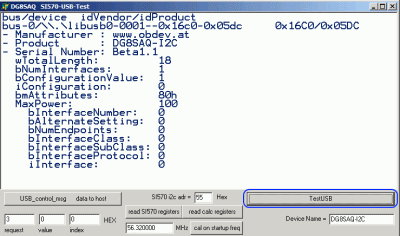
Click on theTestUSBbutton - you should see the results above
Click on theRead Si570 Registersbutton - you may see results similar to those above. No Si570 is the same, registers 10, 11 & 12 are likely to be different, the frequency will be around 56.32MHz> The main thing is that the frequency should be close to the expected startup, normally 56.32 +/- perhaps 0.001MHz. See also Alan G4ZFQ's message on the Softrock reflector.
Enter 14.1 in the "MHz" field and click on theset frequency by registerbutton (see above) to command the Si570 to operate at 14,100,000 Hz. This sets the Si570's frequency to 14.1 MHz
Note: the Si570's address is 55 hex. Some softwares use the hex address, others, e.g., Rocky, use the decimal representation, 85.- Now, press the
Read Si570 Registersbutton ant the following screen should be displayed: 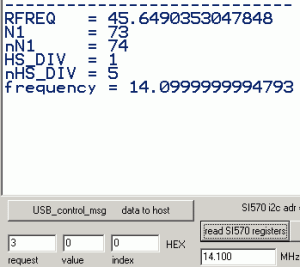
LO Output - Receiver
Test Setup
This procedure will test this stage to determine whether it is outputting the correct frequency (4x the desired center frequency). It involves setting Rocky up for a desired center frequency of 3.525 MHz, such that Rocky will command the Si570 to output a signal at 4x that value, or 14.100 MHz. A ham transceiver will be required to detect the signal at 14.100 MHz.
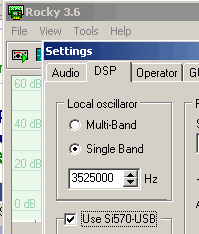
The best order for connection of cables to the v9.0 board would be plug in the audio cable to the soundcard line-in, connect the +12 to the v9.0 board and then plug in the USB cable followed by the antenna connection.
- download and install Rocky (if not already done)
- Run Rocky and click on
View/Settings/DSP - Check in the "Use Si570 USB" checkbox
- Click on the "single band" option button in the "Local Oscillator" box
- Enter 3525000 into the "Hz" field. This tells Rocky to configure the Si570 for 4 times the desired center frequency of 3.525 MHz
- fashion a small wireloop "antenna" to plug into Pin 4 of J1
- connect a wire to your transceiver's RX ANT jack and loop it through the "antenna" in pin 4 of J1
- Tune the transceiver to receive at 14.100 MHz (4x 3.525 MHz)
- Apply power to the board
- Connect the USB cable from the board to the PC
- In Rocky, click on
File/Start Radioto turn on Rocky's SDR program and send the frequency command to the board - The receiver should detect the signal
- go back to
View/Settings/DSPand change the "Hz" field to 3530000 and tune the RX to receive at 14.120 MHz. You should hear the signal at this new frequency
LO Output (Scope/Freq Counter)
The Local Oscillator should output a signal at the four times the center frequency selected by Rocky.
Do not attempt this measurement unless you have a calibrated scope of very good quality and correctly compensated probes.
Test
-

- Tune the USB oscillator settings to get a center frequency of 7.046 MHz
- Apply power to the board
- Test the output of (U8 in the LVDS version of the kit or U4 in the CMOS version)
at pin 4 of J1: the frequency should be 28.184
MHz (4 times the desired center frequency of 7.046 MHz).
The AC pk-pk voltage should be aproximately or less than 3.3 V p-p.
The waveform should approximate be a square wave. - If you get 56.32 MHz (or 14.08 times 4) with tuning set as above, or regardless
of the frequency selected, this means:
- U2 has been incorrectly installed or
- pins 7 or 8 of U4 may have bad solder joints
- The USB interface is not working to receive the control signals from the software
- The software is not configured correctly to use the USB interface
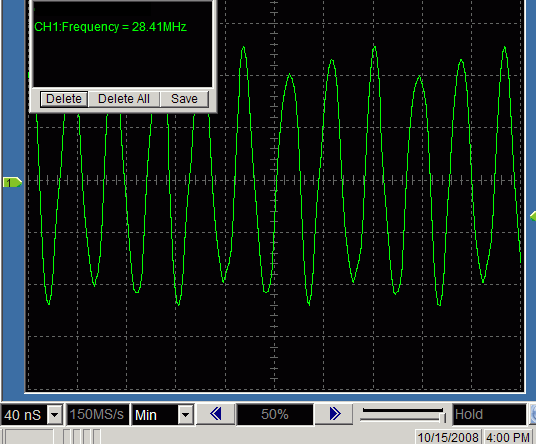
LO Output Test for 40m (frequency measurement is approximate, at best)